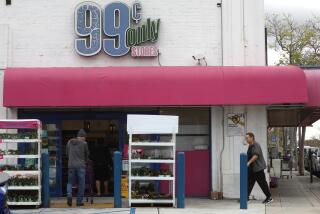1995-96 REVIEW AND OUTLOOK : TRENDS : The Biz Quiz
- Share via
Who swallowed Dr Pepper? Why are travel agents fuming? And why did Benjamin Franklin need a face-lift? Here is The Times’ annual test of your knowledge of news events from the business world in 1995, so sharpen your pencils.
(Answers are at the end.)
1. AT&T; Corp. decided to break itself into three parts, the second split for the telecommunications giant. When did the first breakup take effect?
a) 1980
b) 1982
c) 1984
d) 1919
2. This man won the 1995 Nobel Memorial Prize for Economic Science, becoming the fifth University of Chicago professor to capture the award in the last six years:
a) Michael Boskin
b) Robert Lucas Jr.
c) Milton Friedman
d) John Maynard Keynes
3. The Dow Jones industrial average crossed 4,000 last February and 5,000 nine months later. When was the last time it gained 1,000 points in one year?
a) 1994
b) 1982
c) 1928
d) Never
4. The U.S. currency was overhauled for the first time in nearly 70 years to thwart counterfeiters. What was the denomination of the bill that was changed?
a) $20
b) $50
c) $100
d) $1,000
5. After Lotus Development Corp. was bought by IBM Corp. for $3.5 billion, this man quit as the software giant’s chief executive:
a) Ryal Poppa
b) Louis Gerstner Jr.
c) James Manzi
d) Steve Jobs
6. The amount of money invested in all types of mutual funds in 1995 surpassed this figure:
a) $1.0 trillion
b) $1.5 trillion
c) $2.0 trillion
d) $2.5 trillion
7. Broadway Stores Inc. was acquired by this parent company of Macy’s:
a) Wal-Mart Stores Inc.
b) Dayton Hudson Corp.
c) Federated Department Stores Inc.
d) May Department Stores Co.
8. 1995 marked the second straight year that market interest rates fell. True or false?
9. This media captain took control of the Home Shopping Network:
a) Ted Turner
b) Laurence Tisch
c) Gerald Levin
d) Barry Diller
10. Two of the major railroads in California agreed to be acquired. Name them:
a) Union Pacific Corp.
b) Southern Pacific Rail Corp.
c) Burlington Northern Inc.
d) Santa Fe Pacific Corp.
11. The prime lending rate ended 1995 at 8.5%; what was the rate when the year began?
a) 7.5%
b) 8.0%
c) 8.5%
d) 9.0%
12. Seagram Co.’s purchase of 80% of MCA Inc. put this executive in charge of a major Hollywood studio:
a) Michael Ovitz
b) Edgar Bronfman Jr.
c) Jeff Sagansky
d) Peter Chernin
13. Dr Pepper/Seven-Up Cos. was bought by this beverage powerhouse for $1.7 billion:
a) Coca-Cola Co.
b) Cadbury-Schweppes
b) PepsiCo Inc.
d) Anheuser-Busch Cos.
14. A revolt was sparked among travel agents after this airline became the first to cap the agents’ commissions:
a) Continental
b) TWA
c) Delta
d) United
15. Forbes’ list of the 400 richest Americans showed Bill Gates and Warren Buffett remained first and second, respectively. Who was third?
a) Sumner Redstone
b) Paul Allen
c) Samuel Newhouse Jr.
d) John Kluge
16. Hailed as among the best money managers Wall Street has produced, this “hedge fund” expert decided to retire at age 54:
a) George Soros
b) Peter Lynch
c) Michael Steinhardt
d) Leon Cooperman
17 After pricing its initial offering at $28 a share, this software company saw its stock skyrocket to $71 in its first day of trading:
a) Intel Corp.
b) Xircom Inc.
c) Netscape Communications Corp.
d) Xytronyx Inc.
18. The U.S. dollar dropped to post-World War II lows against which of the following currencies:
a) German mark
b) British pound
c) Swiss franc
d) Japanese yen
Answers:
1) c
2) b
3) d
4) c
5) c
6) d
7) c
8) False
9) d
10) b,d
11) c
12) b
13) b
14) c
15) d
16) c
17) c
18) a,d
More to Read
Inside the business of entertainment
The Wide Shot brings you news, analysis and insights on everything from streaming wars to production — and what it all means for the future.
You may occasionally receive promotional content from the Los Angeles Times.











